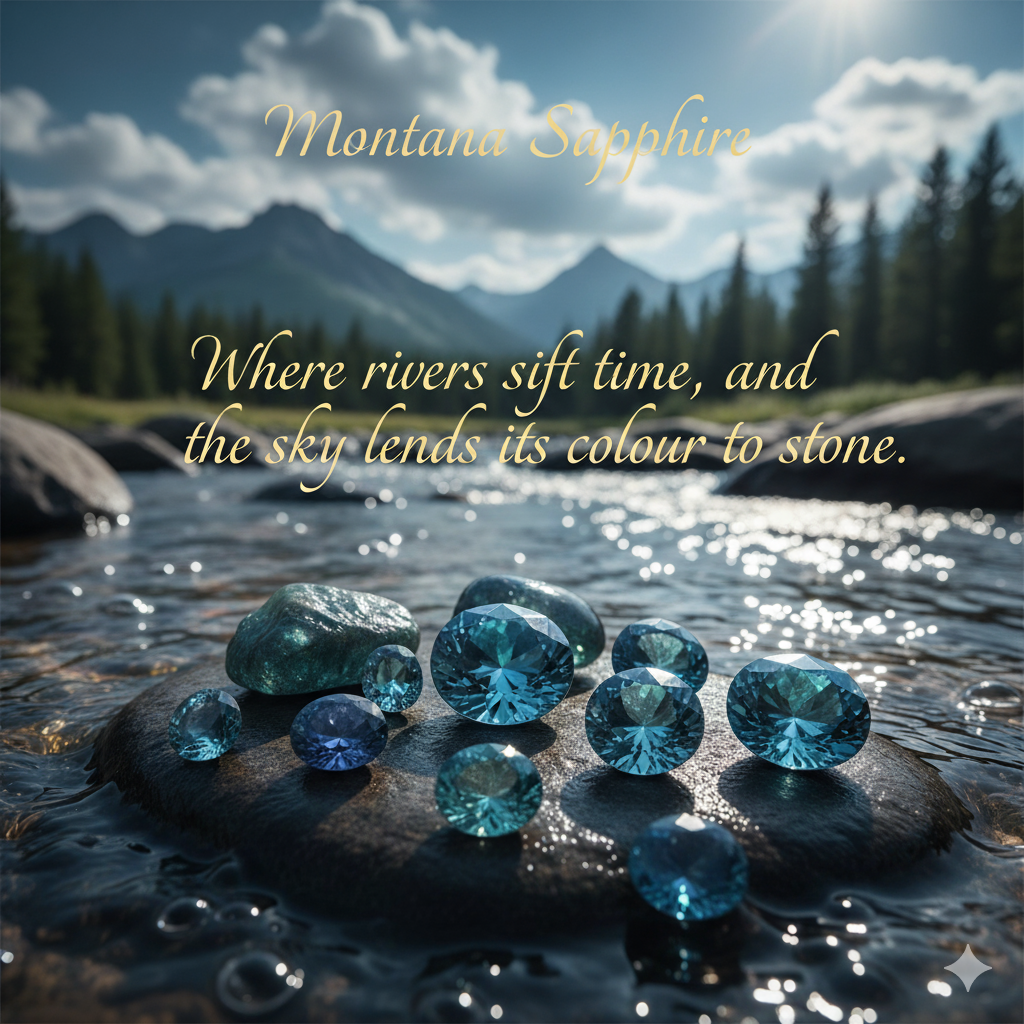Montana Sapphires: The Untamed Blues of the American West
Where rivers sift time, and the sky lends its color to stone.
1. The Land of Big Sky and Small Miracles
Beneath Montana’s endless horizon — where pine forests meet the folded shoulders of the Rockies — lies one of gemology’s quietest revolutions.
Here, sapphire is not mined in marble or schist, but found in riverbeds, washed free by centuries of snowmelt and glacial movement.
These are the Montana Sapphires — stones that shimmer with the light of the northern sky.
They are not dramatic or regal like Srilankan or Burma; they are grounded, subtle, clean — the sapphires of honesty rather than opulence.
2. Geography of Purity
Montana hosts several gem-producing regions across the western half of the state, each born of volcanic and alluvial processes rather than metamorphic marble.
Key Deposits:
- Yogo Gulch (Judith Basin County) – classic cornflower-blue sapphires from primary dike rock.
- Rock Creek (Philipsburg) – pastel-toned, colour-changing sapphires in gravel beds.
- Dry Cottonwood Creek & Missouri River – diverse hues from green to lavender, found in alluvial gravels.
All Montana sapphires share a unique transparency and fine crystal definition — a testament to their high-iron, low-titanium chemistry, producing delicate, icy hues.
3. The Birth of a Gem in the American West
Montana’s sapphires were first discovered in the 1860s by gold miners panning the Missouri River.
To their surprise, the “blue pebbles” clogging sluices were harder than quartz — and impervious to wear.
By the 1880s, industrial interests recognized them as sapphire, using them first for watch bearings and abrasives before gem use gained recognition.
By the early 1900s, Yogo sapphires had become prized among European jewelers, including Tiffany & Co., which declared them “the finest in America.”
Today, Montana remains the only U.S. state producing gem-quality sapphires in commercial quantities.
4. The Science of the Western Blue
Unlike metamorphic deposits in Asia, Montana sapphires are magmatic — crystallized in lamprophyric and basaltic dikes or freed into secondary river gravels.
| Property | Description |
|---|---|
| Chemical Formula | Al₂O₃ (Corundum) |
| Coloring Agents | Iron, titanium (minor), chromium (rare) |
| Hardness | 9.0 on Mohs scale |
| Specific Gravity | 4.00 |
| Refractive Index | 1.76–1.77 |
| Pleochroism | Blue–greenish blue |
| Fluorescence | Weak to moderate |
| Treatments | Commonly heat-treated to enhance colour |
Because they form in iron-rich rock, untreated Montana sapphires display a silvery, steel-blue tone — cooler and lighter than traditional sapphires, with flashes of green or lavender.
When heat-treated (usually at 1700°C in controlled conditions), these tones shift to vivid cornflower or teal blues, rivaling Sri Lankan and Australian stones.
5. The Yogo Phenomenon
The crown jewel of Montana’s sapphire story is Yogo Gulch, located near Lewistown in central Montana.
Here, sapphires are not alluvial but found within a narrow lamprophyre dike running through limestone — the only primary sapphire deposit in the U.S.
Distinctive traits:
- Consistent cornflower-blue colour without zoning.
- Naturally clean and evenly saturated — no heat treatment required.
- Sizes small (usually under 1.5 ct), but colour and clarity nearly flawless.
Yogo sapphires are revered for their “from-the-ground perfection.”
They symbolize America’s quiet excellence — stones that never needed enhancement to be worthy of admiration.
6. Rock Creek — The Rainbow of Blues
Rock Creek, near Philipsburg, is the heart of Montana’s modern sapphire industry.
Here, sapphires occur in ancient alluvial gravels, mined both by hand and through environmentally responsible mechanized washing.
What makes Rock Creek special is colour diversity — blue, teal, green, yellow, pink, and even parti-coloured stones emerge from the same gravel bed.
When heat-treated, these subtle hues evolve into bright, vivid blues that rival Yogo stones in beauty, if not rarity.
Rock Creek sapphires are also famous for their colour-change effect — shifting from bluish in daylight to purplish under incandescent light, akin to fine alexandrite.
7. Missouri River and Dry Cottonwood
The Missouri River near Helena and Dry Cottonwood Creek near Deer Lodge yield sapphires of exceptional clarity.
These are rounded, waterworn crystals — survivors of thousands of years of glacial migration.
Their colours tend toward pastel blue, mint green, or faint pink, often faceted into elegant, understated gems that suit modern minimalism.
They embody Montana’s visual signature: cool elegance, never flamboyance.
8. The Colours of the Sky
| Hue | Description |
|---|---|
| Cornflower Blue | Yogo’s signature — unheated, pure, and steady. |
| Teal Blue | Rock Creek’s gift — blends of blue and green. |
| Steel Blue / Ice Blue | Missouri River — refined and crystalline. |
| Lavender-Purple | Trace-chromium sapphires with colour-change behaviour. |
| Peach-Pink | Rare and collectable; pastel tones after gentle heating. |
Every hue in Montana seems borrowed from its sky — subtle, breathable, filled with light.
9. Ethical Mining and the Spirit of the West
Montana’s sapphire mining is among the world’s most environmentally responsible.
The industry operates under strict state regulations, with full land reclamation and water treatment after extraction.
There are no open pits or chemical leaching — just gravel washing and careful separation.
This commitment makes Montana sapphires highly sought by ethical jewellers worldwide.
They are proof that beauty and integrity can coexist — that a gemstone can shine without casting a shadow.
10. The Role of Heat Treatment
Unlike Yogo stones, most Montana sapphires are lightly heat-treated to intensify their blue.
This process is stable, permanent, and accepted within gemology, yet clearly disclosed in ethical trade.
What makes Montana’s approach exemplary is transparency — no deception, no synthetic diffusion, only enhancement of what nature already gave.
11. Global Recognition
In the 21st century, Montana sapphires have evolved from regional curiosities to global design icons.
Brands such as Brilliant Earth, Tiffany & Co., and Omi Privé now champion them as symbols of responsible luxury.
They appeal especially to younger collectors seeking authentic, traceable, unpretentious beauty.
12. Collector Appeal
Connoisseurs prize Montana sapphires for:
- Traceable origin — verifiable provenance.
- Ethical mining — low ecological footprint.
- Unique colours — teal, pastel, steel-blue.
- Natural fluorescence under daylight.
- Unheated Yogo stones — true geological perfection.
Though rarely large, their charm lies in proportion — every facet seems to echo the landscape that birthed it.
13. Auction and Market Insight
Montana sapphires have entered the global auction stage with quiet confidence:
- Bonhams Los Angeles, 2020: 3.2 ct Yogo sapphire — USD 48,000.
- Christie’s New York, 2022: suite of Rock Creek sapphires (total 14.8 ct) — USD 62,000.
- Phillips Geneva, 2024: 2.9 ct unheated Yogo sapphire — USD 73,000.
Prices remain moderate compared to Burma or Kashmir, but rising steadily with demand for ethical provenance.
14. Comparison Table
| Feature | Montana | Kashmir | Sri Lanka | Madagascar |
|---|---|---|---|---|
| Formation Type | Magmatic / Alluvial | Metamorphic | Metamorphic | Magmatic |
| Colour Tone | Cool, pastel, teal | Velvety cornflower | Medium, bright | Deep, vibrant |
| Transparency | Excellent | Velvety | Good | Good |
| Treatment | Commonly heat-treated | Unheated (historic) | Often heated | Often heated |
| Ethics & Traceability | High | Limited | Moderate | Variable |
Montana’s sapphire is not a rival to Kashmir — it is a new chapter in sapphire ethics and clarity.
15. The Emotional Character
Montana sapphires feel different.
Their blue carries the honesty of air, not the density of luxury.
They are clear, open, and kind.
They appeal to people who prefer solitude over spotlight — the collector who values story over spectacle.
They are the sky’s reflection made permanent.
16. PreciousCarats Reflection — The Colour of Integrity
Montana sapphires remind us that not all beauty is exotic — some is born quietly, at home.
They carry the gentleness of rivers, the patience of snowmelt, and the soul of mountains that have seen no wars.
At PreciousCarats, we revere Montana sapphire as a gem of clarity in conscience and colour — proof that purity need not travel far, only deep.
Not every treasure comes from the East. Some are found where the sky meets the earth — and both are equally blue.

